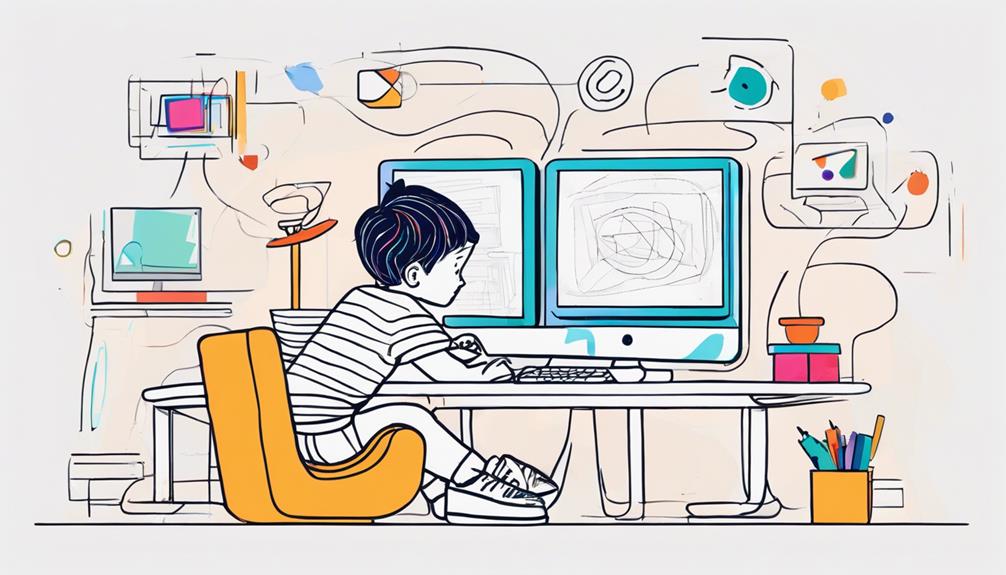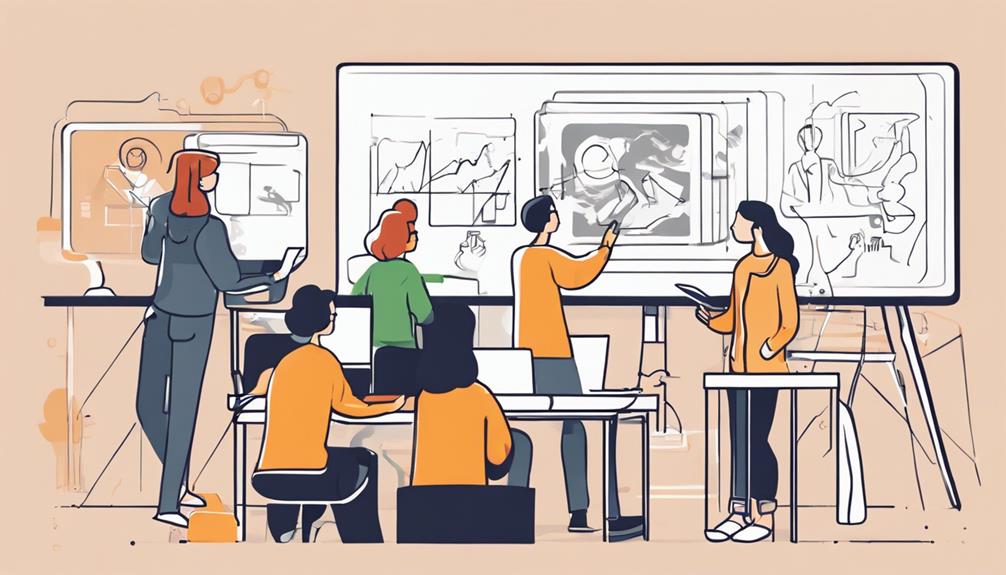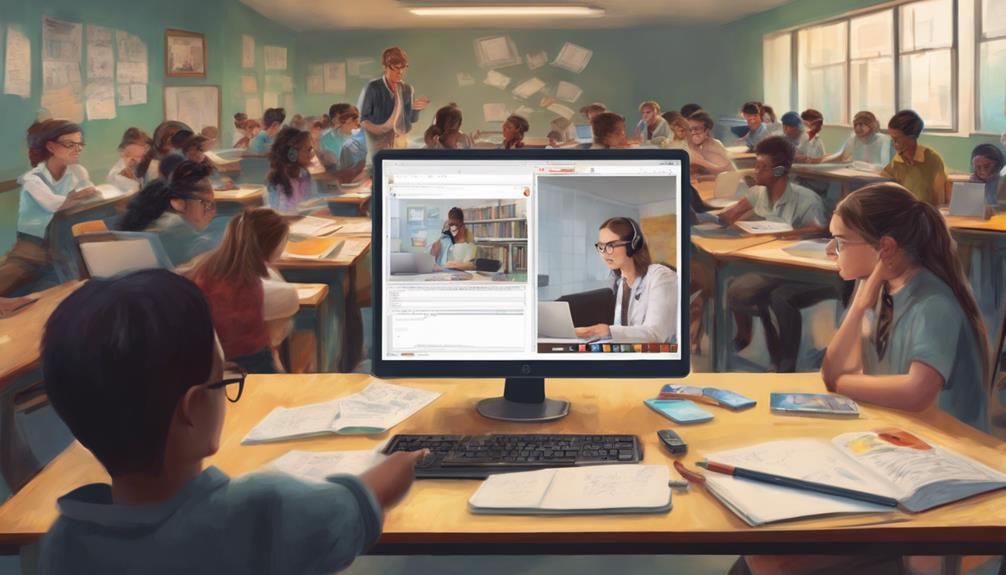Online learning, a method of education delivery through digital platforms, has gained significant attention in recent years. Its definition extends beyond mere virtual classrooms; it encompasses a diverse range of tools and techniques that redefine traditional learning paradigms. As technology continues to evolve, the landscape of online education is continuously changing, presenting both opportunities and challenges for learners and educators alike. The intricacies of this dynamic educational medium warrant a closer examination to truly grasp the nuances and implications of online learning in the modern era.
Key Takeaways
- Online learning offers flexibility and accessibility without physical presence.
- It utilizes interactive tools and platforms for engaging and dynamic learning experiences.
- Virtual education fosters self-paced learning and skills development globally.
- Evolution of online education revolutionizes traditional learning methods and enhances student-instructor interaction.
Definition of Online Learning

Online learning, also known as distance education, is the method of delivering educational content and instruction through digital platforms over the internet. This mode of learning provides students online with the flexibility to engage in web-based courses, video conferencing, and self-paced programs remotely. Asynchronous learning, a key feature of online education, allows students to access learning materials and complete assignments at their own pace without the need for real-time interaction with instructors or peers. This flexibility caters to a diverse range of students worldwide who may have varying schedules or time zone differences. By leveraging learning management systems (LMS), online learning institutions facilitate communication, content delivery, and assessment processes efficiently. Through asynchronous learning opportunities, students can take courses and earn degrees without being physically present on a campus, making education more accessible and adaptable to individual needs and circumstances.
Evolution of Online Education
The evolution of online education has been marked by significant growth and the pervasive influence of advancing technologies. This progression has revolutionized the way individuals access and engage with educational content, transcending geographical barriers. The impact of technology on online education has reshaped traditional learning paradigms, offering a more dynamic and inclusive approach to acquiring knowledge and skills.
Online Education Growth
Emerging alongside the rapid expansion of the internet in the 1990s, the evolution of online education has fundamentally transformed traditional learning paradigms. This growth has been particularly prominent in higher education and distance learning, allowing institutions to cater to a broader and more diverse student base globally. Through online learning platforms, students can access academic programs from various locations, promoting inclusivity and flexibility in education. The flexibility of online courses enables students to progress at their own pace towards degrees or certificates. Furthermore, the evolution of online education has introduced both asynchronous and synchronous learning approaches, enhancing communication and interaction between students and instructors.
| Benefits of Online Education | |
|---|---|
| Global Accessibility | Enhanced Flexibility |
| Inclusivity | Improved Interaction |
Impact of Technology
With the ever-evolving landscape of technology, the evolution of online education has revolutionized the traditional methods of learning. The integration of learning management systems (LMS) has played a pivotal role in enhancing the delivery of online education. These systems have streamlined processes, allowing for efficient organization and dissemination of educational materials. Additionally, the incorporation of asynchronous and synchronous online interactions has enriched the learning experience for students, fostering collaboration and engagement. Communication tools such as discussion threads and emails further facilitate effective participation in online learning environments. The advancements in technology have not only transformed educational approaches but have also provided flexibility and accessibility to a diverse range of learners globally, reshaping the future of education.
Advantages of Virtual Learning

Enhancing educational accessibility and flexibility, virtual learning presents numerous advantages for modern learners. One key benefit is the flexibility it offers in terms of learning pace and schedule, accommodating the diverse lifestyles and commitments of students. Additionally, virtual learning is cost-effective compared to traditional in-person courses, making education more accessible to a wider range of learners. Another advantage is the access to a diverse selection of courses that may not be available locally, expanding educational opportunities for students. Moreover, virtual learning allows students to engage in self-paced learning tailored to their individual needs, promoting personalized educational experiences. Lastly, virtual learning enhances critical thinking, problem-solving, and technology skills development, preparing students for the challenges of the modern world.
| Advantages of Virtual Learning | |
|---|---|
| Flexibility in learning pace | Cost-effective compared to traditional courses |
| Access to diverse course selection | Self-paced learning tailored to individual needs |
| Expands educational opportunities | Enhances critical thinking, problem-solving, technology skills |
Challenges of E-Learning
The transition to online learning, while offering numerous advantages, also brings forth significant challenges that impact the educational experience of learners. In the realm of distance education, one of the primary challenges is the lack of face-to-face interaction, leading to feelings of isolation and reduced socialization opportunities among students. Additionally, technical issues such as internet connectivity problems or platform glitches can disrupt the learning process, impeding the smooth flow of the learning process. Another critical challenge is the limited access to hands-on resources like laboratories or equipment, which hinders practical learning experiences essential for certain subjects. Moreover, maintaining student engagement and motivation without the physical classroom dynamics poses a significant hurdle in the online learning process. Effective communication and feedback mechanisms are crucial in addressing misunderstandings and clarifying concepts in remote e-learning setups, emphasizing the need for robust support systems in the digital learning environment.
Online Learning for Children

Online learning for children presents numerous benefits, such as tailored learning experiences and access to interactive tools that enhance engagement and understanding. These tools can help children grasp complex concepts through visual aids, simulations, and interactive quizzes, fostering a more interactive and dynamic learning environment. By incorporating such features, online platforms can cater to diverse learning styles and offer a more engaging educational experience for young learners.
Benefits for Kids
Exposing children to online learning platforms can significantly broaden their educational opportunities and cater to their individual learning needs. Online courses provide a unique set of benefits for kids, such as:
- Self-Paced Learning: Children can progress at their own speed, focusing on areas where they need more practice.
- Access to Diverse Courses: Internet-based learning offers a wide range of courses not always available locally, allowing children to explore various subjects.
- Enhanced Skills Development: Online learning enhances critical thinking, problem-solving, and technology skills in children, preparing them for the digital age.
- Flexibility and Convenience: Kids can learn from anywhere, at any time, offering flexibility that traditional classroom settings may not provide.
Interactive Learning Tools
Incorporating interactive learning tools into children's online educational experiences revolutionizes traditional learning methods by engaging young learners through dynamic and personalized multimedia resources. These tools, such as educational games, quizzes, virtual simulations, and interactive videos, enhance the education system by catering to individual learning styles. Features like gamification, progress tracking, and immediate feedback on online platforms keep children motivated and actively involved in their learning programs. Through interaction with digital content and collaboration in virtual classrooms, children develop critical thinking, problem-solving skills, and digital literacy essential for their academic and personal growth.
| Interactive Learning Tools | ||
|---|---|---|
| Educational Games | Quizzes | Virtual Simulations |
| Interactive Videos | Gamification | Progress Tracking |
| Immediate Feedback | Group Activities | Collaboration with Peers |
Adult Education Online
Adult education in the digital realm provides a flexible and accessible avenue for adults seeking to advance their knowledge and skills through online platforms.
- Flexibility: Online adult education offers the flexibility for individuals to learn at their own pace and at times convenient to them, accommodating busy schedules.
- Diverse Programs: Online adult education programs cater to various needs, including skill enhancement, career progression, and personal enrichment, providing a wide array of options for adult learners.
- Accredited Institutions: Many reputable universities and institutions offer online courses and degree programs tailored specifically for adult learners, ensuring quality education and recognition.
- Balanced Lifestyle: Adult learners benefit from the convenience of online education, allowing them to balance work, family commitments, and studies effectively without geographical constraints.
Online adult education not only provides a platform for continuous learning but also incorporates interactive tools, resources, and support services to enhance the learning experience for adult students, making it a valuable and effective mode of education for the modern adult learner.
Skills Development Through E-Courses

Skills development through e-courses in online learning is a strategic approach to enhancing competencies essential for navigating the demands of modern professional environments. E-courses offer a platform for individuals to cultivate skills like critical thinking, problem-solving, and technology proficiency. These courses allow for self-paced learning, accommodating diverse needs and preferences. Additionally, they provide access to a broad array of subjects and topics that may not be readily available locally. Online learning platforms further augment skill development through interactive tools and resources, creating an engaging learning experience. Importantly, the skills acquired through e-courses can be directly applied to real-world scenarios and professional settings, making them practical and valuable. By leveraging the flexibility and resources offered by online learning, individuals can continuously enhance their skill sets to meet the evolving demands of today's dynamic work environments.
Digital Resources for Learning
Digital resources for learning play a fundamental role in modern educational environments, providing essential tools and platforms for facilitating interactive and engaging online learning experiences. These resources are crucial for education in distance settings. Here are four key elements:
- Online Course Management Systems (CMS) like Moodle and Sakai serve as vital tools for delivering curriculum and managing educational content efficiently in distance education.
- 3D immersive environments offer students interactive and social learning experiences, enhancing their understanding of complex concepts through virtual simulations.
- Supplementary tools available in online systems help improve the overall learning experience by providing additional resources such as videos, quizzes, and interactive modules.
- 3D virtual worlds contribute to collaborative learning and peer mentoring among students, fostering a sense of community and teamwork in online educational settings.
Interactive Online Platforms

Interactive online platforms play a crucial role in online learning by enabling real-time interactions between students and instructors. These platforms offer a range of features such as live chats, video conferencing, and collaborative tools that enhance the learning experience. Through virtual classrooms, students can actively engage in discussions, receive immediate feedback, and participate in interactive activities that promote a sense of community and foster active learning.
Virtual Classrooms Benefits
Virtual classrooms on interactive online platforms revolutionize traditional education by enabling real-time engagement between instructors and students. These platforms facilitate interactive discussions, live Q&A sessions, and collaborative activities. Students can participate in polls, quizzes, and group projects to enhance their learning experience. Virtual classrooms provide a dynamic and engaging environment with multimedia content and interactive tools. Features like screen sharing, virtual whiteboards, and breakout rooms promote active participation and group work.
Engaging Multimedia Content
Engaging multimedia content within online learning platforms plays a crucial role in enhancing student interaction and learning outcomes through immersive educational experiences. Interactive online platforms, such as OLaM, provide this content, incorporating interactive elements to increase student engagement. By offering engaging multimedia resources, OLaM caters to diverse student needs and preferences, fostering flexibility in learning time and location. Additionally, virtual avatars (VAs) within these platforms contribute to emotional support and enhance the overall learning experience. Design considerations for emotional scaffolding using VAs include aspects like visual persona and tailored verbal messages. Overall, the integration of interactive elements and engaging multimedia content in online learning platforms like OLaM significantly contribute to improved student engagement and learning outcomes.
Collaborative Online Tools
In the realm of online education, the utilization of collaborative online tools has revolutionized the dynamics of virtual classrooms, enabling real-time interaction and fostering seamless group work among students and instructors. These tools include features like chat functions, video conferencing, and collaborative document editing for enhanced collaboration. Interactive online platforms offer engagement opportunities through discussion forums, virtual whiteboards, and shared screen capabilities, allowing students to work together on projects and engage in group discussions. Immediate feedback from peers and instructors on these platforms enhances the learning experience by promoting teamwork, communication skills, and active participation in online learning environments.
Accredited Online Programs

Meeting stringent quality standards set by accrediting agencies, accredited online programs offer educational courses or degrees that ensure students receive a recognized and respected qualification upon completion. Accreditation plays a crucial role in verifying the credibility and quality of online education, serving as a benchmark for academic excellence. Institutions offering accredited online programs undergo thorough evaluation to demonstrate compliance with established academic standards and educational requirements. This rigorous process not only validates the legitimacy of the programs but also ensures that students receive a high-quality education that aligns with industry standards. Graduating from an accredited online program not only enhances students' employability but also opens up a myriad of opportunities for career advancement and further studies. Accreditation is often a prerequisite for transferring credits between institutions, highlighting the importance of choosing accredited programs to maximize the benefits of online learning.
Future Trends in Virtual Education
As online education continues to advance, the future of virtual learning is poised to embrace innovative approaches that cater to individualized and interactive learning experiences. The evolution of virtual education towards more personalized and interactive methods is evident in the following trends:
- Personalized Learning Paths: Virtual education is moving towards tailoring learning experiences to meet the specific needs and preferences of each student, allowing for a more customized educational journey.
- Adaptive Technologies: The integration of adaptive technologies into online learning platforms enables the system to adjust to the learner's pace, style, and progress, enhancing the effectiveness of teaching and learning.
- Engaging and Interactive Tools: Emerging trends in virtual education focus on providing tools and resources that promote student engagement and interactivity, creating a more dynamic and immersive learning environment.
- Virtual and Augmented Reality Integration: The future of online education may see the incorporation of virtual reality and augmented reality technologies into learning platforms, offering students a more immersive and interactive educational experience.
Frequently Asked Questions
What Is the Meaning of Online Learning?
The meaning of online learning encompasses the delivery of educational content and instruction via the internet. It offers benefits such as flexibility in scheduling and location, enabling students to engage with course materials at their own pace. However, challenges like maintaining engagement and interaction in a virtual setting may arise. Online learning caters to diverse learners, providing opportunities to earn degrees or certificates remotely, connecting students with academic institutions worldwide.
What Is the Meaning of Online Teaching?
Online teaching involves delivering educational content through digital platforms, enabling virtual instruction outside traditional classrooms. An intriguing statistic is that online education has seen a 173% increase in enrollment since 2005 (Babson Survey Research Group). This method utilizes tools like video conferencing and learning management systems to engage students effectively. It promotes flexibility, personalized learning experiences, and access to a wide range of educational resources in the digital realm.
What Are the Words That Best Describe Online Learning?
Interactive engagement and virtual classrooms epitomize online learning. These words encapsulate the dynamic nature of digital education, where students actively participate in discussions, collaborate on projects, and engage with course materials in real-time. Online platforms enable learners to interact with instructors and peers, fostering a sense of community despite physical distances. This interactive approach enhances the educational experience, making learning more engaging and effective.
What Exactly Are Online Classes?
Online classes, also known as virtual courses, are educational programs delivered through the internet. They provide a flexible learning environment where students can access lectures, assignments, and assessments remotely. These classes offer convenience, enabling individuals to pursue education without physical presence on campus. Benefits include accessibility, self-paced learning, and a variety of platforms for interaction. Overall, online classes aim to provide an effective and efficient means of education in a digital age.
Conclusion
In conclusion, online learning has revolutionized the way education is delivered, offering flexibility and accessibility to a wide range of learners. Despite the challenges it presents, such as lack of face-to-face interaction, the advantages of virtual education cannot be overlooked. As virtual education continues to evolve and adapt to the changing landscape of technology, it is clear that online learning is here to stay, paving the way for a more dynamic and inclusive educational experience.
